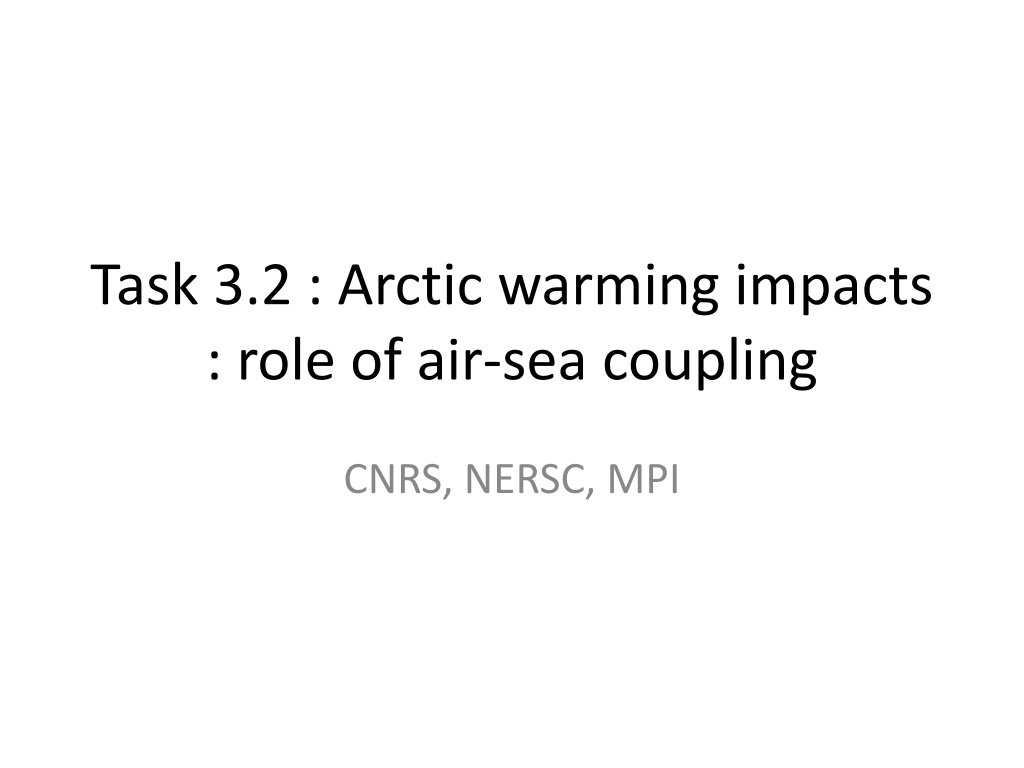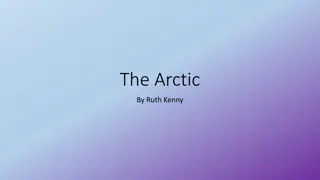Understanding the Impact of Arctic Warming Through Air-Sea Coupling
Investigate the role of air-sea coupling in amplifying or dampening the impact of Arctic warming on northern continents using coordinated coupled model experiments. Explore the mechanisms bridging Arctic impacts in the Northern Hemisphere via North Pacific sea surface temperature changes. Focus on the feedback processes and ocean-atmosphere interactions affecting Arctic warming and ocean circulation. Address outstanding questions on the relative importance of Atlantic and Pacific feedbacks, model uncertainties, and time scales for these feedbacks.
- Arctic warming
- Air-sea coupling
- Ocean-atmosphere interactions
- Northern Hemisphere
- Model uncertainties
Download Presentation

Please find below an Image/Link to download the presentation.
The content on the website is provided AS IS for your information and personal use only. It may not be sold, licensed, or shared on other websites without obtaining consent from the author. Download presentation by click this link. If you encounter any issues during the download, it is possible that the publisher has removed the file from their server.
E N D
Presentation Transcript
Task 3.2 : Arctic warming impacts : role of air-sea coupling CNRS, NERSC, MPI
Link with Summer Asian Monsoon Guo et al. 2014 Review of Vihma et al. 2014
Mechanism brindging Arctic impacts in Northern Hemisphere Through North Pacific SST? SST changes in AOGCM caused by sea ice reduction prescibed in Arctic Guo et al. 2014
Coupled simulation at equilibrium where Arctic sea ice reduction is imposed AGCM Slab coupled to AGCM Full AOGCM Deser et al. 2016, GRL
Merdional energy transport Arctic warming -> albedo reduced in the North Pole -> less energy transported northward. With coupling feedbacks: Ocean dynamical change : transport heat equatorward => mini global warming caused by equatorial warming and water vapor feedbacks. Thermodynamical feedback => interhemispheric changes AGCM AOGCM atm AOGCM oce Deser et al. 2015
Outstanding question: Where do the coupled feedback occur? What are the relative importance of the Altantic and Pacific? What is the robustness of the coupled processes given the model uncertainties? What are the time adjustement and time scale for these feedbacks? Intra-seasonal? Decades? Description of work for Task 3.2 : The amplification/damping effect of active air-sea coupling in establishing the Arctic warming impact on the [ ] northern continents will be investigated using [ ] coordinated coupled model experiments. To represent the observed Arctic warming, we will restore the surface heat flux/sea surface temperature in the Arctic Ocean to the observations (AO-Exp1). The coordinated experiments will enable us to investigate the role of ocean- atmosphere coupling in amplifying or damping the Arctic warming impact [..] and in affecting the ocean circulation [ ].
Methods : AO-Exp1 Models/groups participating : NorESM, IPSL-CM6, MPI-ESM External forcing from CMIP6. Include a heating term in Arctic to melt to restore the sea-ice toward the observation : observed SIC and SST daily/monthly variab? - Prescribe a single pattern of Arctic warming based on obserations? Or - SST restoring as in Kug et al. (2015), relax time scale of 1 day? - Include heat flux anomalies? Ensemble size: 30 or more Duration : 1979 to present
Description of work: Additional experiments will distinguish between the role of the [ ] Atlantic and Pacific oceans by prescribing an AMO phase in the Atlantic (AO-Exp2) or an IPO phase in the Pacific (AO-Exp3) [ ]. Methods : AO-Exp2 and AO-Exp3 Models/groups participating : NorESM, IPSL-CM6, MPI-ESM Same as AO-Exp1, but Atlantic and Pacific state imposed.
2nd method: 1st method: Use a single warm Arctic pattern. Using Pacemaker experiment methodology. Freeze SST in the Atl. or Pac. while Arctic warm (Atl. / Pac. Controls) Prescribed SST/SIC monthly/daily variab. Using the idealized IPO and AMO pattern : - AMO+ and AMO- including Arctic warming. - IPO+ and IPO- including Arctic warming. - Atlantic Pacemaker - Pacific Pacemaker -> nice for intra-seasonal variability and comparison with obs., but small signal. -> nice to study the AMO and IPO atmospheric impacts But more idealized.
DCPP experiments Boer et al. 2016, Geosci. Model Dev.
Idealized AMO pattern and time series Ruprich-Robert et al. 2016, J. Clim.
Idealized IPO time series Boer et al. 2016, Geosci. Model Dev.
Deliverable Deliverable D3.3 Role of ocean- atmosphere coupling in bridging the Arctic warming over lower latitudes Lead: CNRS Report, Public. Due date : Mth 36
Continental snow impacts Compare snow impacts in coupled climate models and AGCM GREENICE experiments























